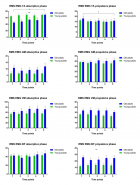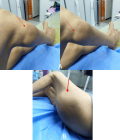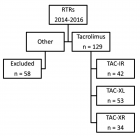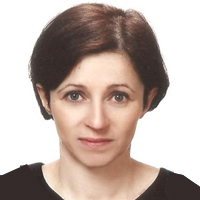Abstract
Research Article
Effects of Fast-Walking on Muscle Activation in Young Adults and Elderly Persons
Camila Fonseca de Oliveira*, Denise Paschoal Soares, Michel Christian Bertani, Leandro José Rodrigues Machado and João Paulo Vila-Boas
Published: 20 January, 2017 | Volume 1 - Issue 1 | Pages: 012-019
Coactivation of agonist and antagonist muscles participates in the regulation of joint stiffness and postural instability. Alterations on muscle activity have been revealed as an important falling risk factor. It is unclear the effects, and age-related differences, of a prolonged demanding task on the muscular coactivation levels. We compared muscle activation amplitude and coactivation of the vastus medialis, biceps femoris, tibialis anterior, and gastrocnemius medialis from surface EMG in 16 young adults (age 21-33) and 8 elderly adults (age 66-72) while fast-walking at 70% of their maximum heart rate. Overall, the elderly demonstrated higher coactivation indexes than the young individuals. Ankle coactivation decreased in the first half of the swing phase, while coactivation at the knee increased in the latter half of the swing phase in our elders. Alterations of muscle activation and coactivation on the knee and ankle were more prominent close to landing and in the swing phase. Our results suggest that these alterations may suggest potential concerns with respect to the risk of falls.
Read Full Article HTML DOI: 10.29328/journal.jnpr.1001002 Cite this Article Read Full Article PDF
Keywords:
Coactivation; Electromyography; Falls in elderly; Fatigue; Activities of daily living
References
- Eurostat (2015) People in the EU - who are we and how do we live?
- Tinetti ME, Speechley M. Prevention of falls among the elderly. N Engl J Med. 1989; 320: 1055-1059. Ref.: https://goo.gl/bT5qfS
- Gandevia SC. Neural control in human muscle fatigue: Changes in muscle afferents, moto neurones and moto cortical drive. Acta Physiol Scand. 1998;162: 275-283. Ref.: https://goo.gl/7vBovO
- Lee LW, Kerrigan DC. Identification of Kinetic Differences Between Fallers and Nonfallers in the Elderly1. Am J Phys Med Rehabil. 1999; 78: 242-246. Ref.: https://goo.gl/251ra3
- Hortobagyi T, DeVita P. Muscle pre- and coactivity during downward stepping are associated with leg stiffness in aging. J Electromyogr Kinesiol. 2000; 10: 117-126. Ref.: https://goo.gl/c6gx10
- Peterson DS, Martin PE. Effects of age and walking speed on coactivation and cost of walking in healthy adults. Gait Posture. 2010; 31: 355-359. Ref.: https://goo.gl/b4TYlP
- Pereira M, Gonçalves M. Effects of fatigue induced by prolonged gait when walking on the elderly. Human Movement. 2011; 12: 242-247. Ref.: https://goo.gl/ZZiJwC
- Fan Y, Li Z, Han S, Lv C, Zhang B. The influence of gait speed on the stability of walking among the elderly. Gait Posture. 2016; 47: 31-36. Ref.: https://goo.gl/lkmB42
- Nagano H, James L, Sparrow WA, Begg RK. Effects of walking-induced fatigue on gait function and tripping risks in older adults. J Neuroeng Rehabil. 2014; 11, 155. Ref.: https://goo.gl/kOw0vX
- Schmitz A, Silder A, Heiderscheit B, Mahoney J, Thelen DG. Differences in lower-extremity muscular activation during walking between healthy older and young adults. J Electromyogr Kinesiol. 2009; 19: 1085-1091. Ref.: https://goo.gl/oonhiz
- Borg GA. Psychophysical bases of perceived exertion. Med Sci Sports Exerc. 1982; 14: 377-381. Ref.: https://goo.gl/ySQrIz
- Zeni JA Jr, Richards JG, Higginson JS. Two simple methods for determining gait events during treadmill and overground walking using kinematic data. Gait Posture. 2008; 27: 710-714. Ref.: https://goo.gl/vHmpdq
- Kellis E, Arabatzi F, Papadopoulos C. Muscle co-activation around the knee in drop jumping using the co-contraction index. J Electromyogr Kinesiol. 2003; 13: 229-238. Ref.: https://goo.gl/BmDBvg
- Hortobágyi T, Solnik S, Gruber A, Rider P, Steinweg K, et al. Interaction between age and gait velocity in the amplitude and timing of antagonist muscle coactivation. Gait Posture. 2009; 29: 558-564. Ref.: https://goo.gl/A7IE5b
- Mian OS, Thom JM, Ardigo LP, Narici MV, Minetti AE. Metabolic cost, mechanical work, and efficiency during walking in young and older men. Acta Physiol (Oxf). 2006; 186: 127-139. Ref.: https://goo.gl/MpOk2h
- Obata H, Kawashima N, Akai M, Nakazawa K, Ohtsuki T. Age-related changes of the stretch reflex excitability in human ankle muscles. J Electromyogr Kinesiol. 2010; 20: 55-60. Ref.: https://goo.gl/XWN8s0
- Longpré HS, Potvin JR, Maly MR. Biomechanical changes at the knee after lower limb fatigue in healthy young women. Clin Biomech (Bristol, Avon). 2013; 28: 441-447. Ref.: https://goo.gl/OwOp46
- Granacher U, Gruber M, Forderer D, Strass D, Gollhofer A. Effects of ankle fatigue on functional reflex activity during gait perturbations in young and elderly men. Gait Posture, 2010; 32: 107-112. Ref.: https://goo.gl/nRBvXS
- Hautier CA, Arsac LM, Deghdegh K, Souquet J, Belli A, et al. Influence of fatigue on EMG/force ratio and cocontraction in cycling. Med Sci Sports Exerc. 2000; 32: 839-843. Ref.: https://goo.gl/v6rQJt
- Pereira MP, Gonçalves M. Muscular coactivation (CA) around the knee reduces power production in elderly women. Arch Gerontol Geriatr. 2011; 52: 317-321. Ref.: https://goo.gl/ooGwxU
- Parijat P, Lockhart TE. Effects of quadriceps fatigue on the biomechanics of gait and slip propensity. Gait Posture. 2008; 28: 568-573. Ref.: https://goo.gl/f0Zyz5
- Hortobágyi T, Mizelle C, Beam S, DeVita P. Old Adults Perform Activities of Daily Living Near Their Maximal Capabilities. J Gerontol A Biol Sci Med Sci. 2003; 58: M453-M460. Ref.: https://goo.gl/Lm6owH
- Winter DA. Foot trajectory in human gait: a precise and multifactorial motor control task. Phys Ther. 1992; 72: 45-53; discussion 54-46. Ref.: https://goo.gl/8mXUr7
Figures:

Figure 1

Figure 2

Figure 3
Similar Articles
-
Effects of Fast-Walking on Muscle Activation in Young Adults and Elderly PersonsCamila Fonseca de Oliveira*,Denise Paschoal Soares,Michel Christian Bertani,Leandro José Rodrigues Machado,João Paulo Vila-Boas. Effects of Fast-Walking on Muscle Activation in Young Adults and Elderly Persons. . 2017 doi: 10.29328/journal.jnpr.1001002; 1: 012-019
-
Factors affecting muscle strength in cancer patients receiving chemotherapyJiro Nakano*,Shun Ishii,Takuya Fukushima,Ayumi Natsuzako,Junya Sakamoto,Minoru Okita. Factors affecting muscle strength in cancer patients receiving chemotherapy. . 2017 doi: 10.29328/journal.jnpr.1001008; 1: 056-066
-
Physical Therapy for Transverse Myelitis: A Case ReportAllison Buchanan,Kelli J Wilkerson,Han-Hung Huang*. Physical Therapy for Transverse Myelitis: A Case Report. . 2018 doi: 10.29328/journal.jnpr.1001017; 2: 015-021
-
The real-time information provision problem in assessing rehabilitation needs among athletes with overtraining syndromePanagiotis Katrakazas. The real-time information provision problem in assessing rehabilitation needs among athletes with overtraining syndrome. . 2022 doi: 10.29328/journal.jnpr.1001044; 6: 009-010
-
Postpartum as the best time for physical recovery and health careShizuka Torashima*,Mina Samukawa,Kazumi Tsujino,Yumi Sawada. Postpartum as the best time for physical recovery and health care. . 2023 doi: 10.29328/journal.jnpr.1001049; 7: 001-007
-
Effectiveness of massage chair and classic massage in recovery from physical exertion: a pilot studyIvi Vaher,Anna-Liisa Tamm*,Marit Salus,Kirkke Reisberg,Aleksandra Vähi,Helena Pallon,Andra Paeste,Bäthel-Betty Pirk,Margus Merila,Thomas Schrader. Effectiveness of massage chair and classic massage in recovery from physical exertion: a pilot study. . 2023 doi: 10.29328/journal.jnpr.1001050; 7: 008-015
-
Effect of Lower Extremity Training in Diabetic Peripheral NeuropathyAnn Reena Rajan*. Effect of Lower Extremity Training in Diabetic Peripheral Neuropathy. . 2024 doi: 10.29328/journal.jnpr.1001056; 8: 001-004
-
Development and Evaluation of a mHealth app - (ReMiT-MS app) for Rehabilitation of Individuals with Relapsing-remitting Multiple Sclerosis - A Mixed Methods, Pragmatic Randomized Controlled Trial - Study ProtocolSolaiyan Rajanchellappa, Dheeraj Khurana*, AGK Sinha, Soundappan Kathirvel, Ashok Kumar, Rajni Sharma. Development and Evaluation of a mHealth app - (ReMiT-MS app) for Rehabilitation of Individuals with Relapsing-remitting Multiple Sclerosis - A Mixed Methods, Pragmatic Randomized Controlled Trial - Study Protocol. . 2024 doi: 10.29328/journal.jnpr.1001060; 8: 022-030
Recently Viewed
-
Leiomyosarcoma in pregnancy: Incidental finding during routine caesarean sectionToon Wen Tang*,Phoon Wai Leng Jessie. Leiomyosarcoma in pregnancy: Incidental finding during routine caesarean section. Clin J Obstet Gynecol. 2021: doi: 10.29328/journal.cjog.1001094; 4: 092-095
-
Adult Neurogenesis: A Review of Current Perspectives and Implications for Neuroscience ResearchAlex, Gideon S*,Olanrewaju Oluwaseun Oke,Joy Wilberforce Ekokojde,Tolulope Judah Gbayisomore,Martina C. Anene-Ogbe,Farounbi Glory,Joshua Ayodele Yusuf. Adult Neurogenesis: A Review of Current Perspectives and Implications for Neuroscience Research. J Neurosci Neurol Disord. 2024: doi: 10.29328/journal.jnnd.1001102; 8: 106-114
-
Late discover of a traumatic cardiac injury: Case reportBenlafqih C,Bouhdadi H*,Bakkali A,Rhissassi J,Sayah R,Laaroussi M. Late discover of a traumatic cardiac injury: Case report. J Cardiol Cardiovasc Med. 2019: doi: 10.29328/journal.jccm.1001048; 4: 100-102
-
A two-phase sonographic study among women with infertility who first had normal sonographic findingsKalu Ochie*,Abraham John C. A two-phase sonographic study among women with infertility who first had normal sonographic findings. Clin J Obstet Gynecol. 2022: doi: 10.29328/journal.cjog.1001117; 5: 101-103
-
Sinonasal Myxoma Extending into the Orbit in a 4-Year Old: A Case PresentationJulian A Purrinos*, Ramzi Younis. Sinonasal Myxoma Extending into the Orbit in a 4-Year Old: A Case Presentation. Arch Case Rep. 2024: doi: 10.29328/journal.acr.1001099; 8: 075-077
Most Viewed
-
Evaluation of Biostimulants Based on Recovered Protein Hydrolysates from Animal By-products as Plant Growth EnhancersH Pérez-Aguilar*, M Lacruz-Asaro, F Arán-Ais. Evaluation of Biostimulants Based on Recovered Protein Hydrolysates from Animal By-products as Plant Growth Enhancers. J Plant Sci Phytopathol. 2023 doi: 10.29328/journal.jpsp.1001104; 7: 042-047
-
Sinonasal Myxoma Extending into the Orbit in a 4-Year Old: A Case PresentationJulian A Purrinos*, Ramzi Younis. Sinonasal Myxoma Extending into the Orbit in a 4-Year Old: A Case Presentation. Arch Case Rep. 2024 doi: 10.29328/journal.acr.1001099; 8: 075-077
-
Feasibility study of magnetic sensing for detecting single-neuron action potentialsDenis Tonini,Kai Wu,Renata Saha,Jian-Ping Wang*. Feasibility study of magnetic sensing for detecting single-neuron action potentials. Ann Biomed Sci Eng. 2022 doi: 10.29328/journal.abse.1001018; 6: 019-029
-
Pediatric Dysgerminoma: Unveiling a Rare Ovarian TumorFaten Limaiem*, Khalil Saffar, Ahmed Halouani. Pediatric Dysgerminoma: Unveiling a Rare Ovarian Tumor. Arch Case Rep. 2024 doi: 10.29328/journal.acr.1001087; 8: 010-013
-
Physical activity can change the physiological and psychological circumstances during COVID-19 pandemic: A narrative reviewKhashayar Maroufi*. Physical activity can change the physiological and psychological circumstances during COVID-19 pandemic: A narrative review. J Sports Med Ther. 2021 doi: 10.29328/journal.jsmt.1001051; 6: 001-007

HSPI: We're glad you're here. Please click "create a new Query" if you are a new visitor to our website and need further information from us.
If you are already a member of our network and need to keep track of any developments regarding a question you have already submitted, click "take me to my Query."

















































































































































